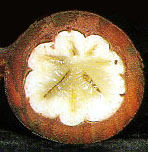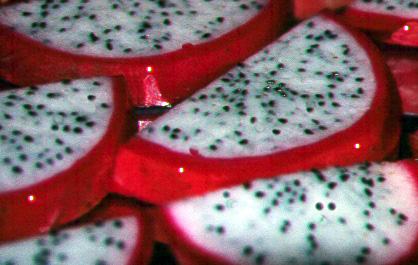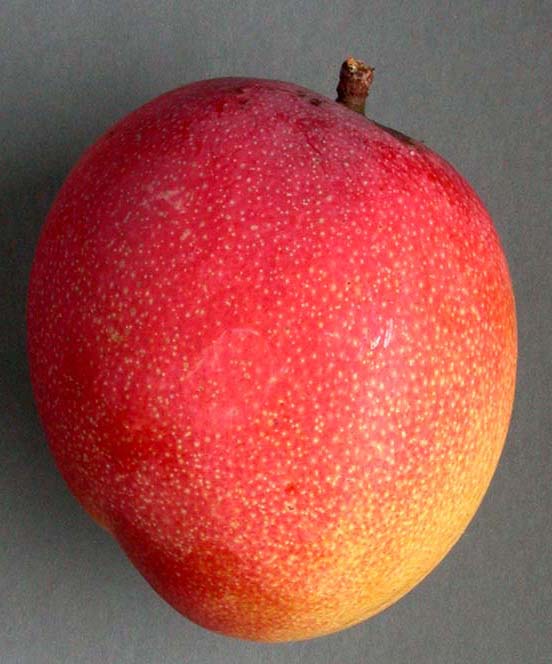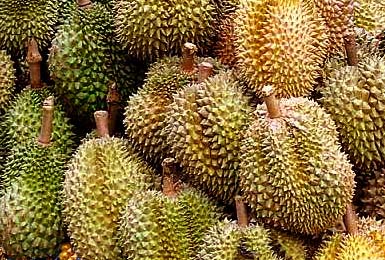Toronto, financial and cultural capital of Canada, home to the third largest theater district in the world, home of “the tallest freestanding structure” (are there taller ones that stand with the aid of others?), exotic fruit paradise.
What? Tropical
fruit? In Canada?
Believe it or not, Canada is a good place for exotic goodies. For one thing the Canadian agriculture department is not as worried about introducing pests and diseases as the American agriculture department. For another thing, Toronto, and many other Canadian cities are quite ethnically diverse with large Asian populations, and they crave and are willing to pay for the fruits of their homelands. As a result of easy importation and high demand one can go to the “old Chinatown” market places of Toronto and buy fresh mangosteen, durian, jackfruit, soursop, sweetsop, dragonfruit, rambutan, lytchee, longan, queenpa, and other fruits. In fact, there are stores there that sell nothing but fruit.
Believe it or not, Canada is a good place for exotic goodies. For one thing the Canadian agriculture department is not as worried about introducing pests and diseases as the American agriculture department. For another thing, Toronto, and many other Canadian cities are quite ethnically diverse with large Asian populations, and they crave and are willing to pay for the fruits of their homelands. As a result of easy importation and high demand one can go to the “old Chinatown” market places of Toronto and buy fresh mangosteen, durian, jackfruit, soursop, sweetsop, dragonfruit, rambutan, lytchee, longan, queenpa, and other fruits. In fact, there are stores there that sell nothing but fruit.
My own tropical fruit
adventure in Toronto happened just this last summer on my second trip
to that city. I had been told that Toronto did have exotic fruits
in its marketplaces, and I stocked up in anticipation of the visit.
On entering Canada this made for an interesting encounter with customs.
I was asked to declare if I had any soil or plant materials… and I truthfully
disclosed I was carrying peat moss with me; naturally the customs agent
was bemused by this. I explained that I'd heard there were all sorts
of exotic fruits in Toronto that I couldn't get in the US and I planned to
put the seeds in peat moss while we stayed at the bed and breakfast.
The customs agent became more skeptical and concerned; I might as well have
asked him if I could remove his gallbladder and dance on it. “You're
going to grow plants in a bed and breakfast in seven days?” he asked, he
then continued “Are you planning to bring back the seeds?” After
I told him that, indeed I was bringing back the seeds he let me pass, and
seemed to make a mental note that I was demented.
The first stop (after checking in to the bed and breakfast) was old Chinatown to search for the fabled fruits. I did not know what would be in stock or where exactly I should look (I had some street names but no addresses). Walking into Chinatown we started seeing some sidewalk produce stands (spilling out from the adjacent stores) and after three or so of these I saw a stand, which was selling mangosteen. I was so excited I yelled out “Oh mangosteen!”. Eventually we walked into the heart of the fruit selling area (the northwest corner of Spadania & Dundas). There at each new discovery I shouted out what I'd found “Rambutan!”, “Dragonfruit!”…. At this point my wife, who enjoys fruit but only as much as a normal person, became a bit perturbed and asked me to calm down. On this first foray I purchased several mangosteens, 10 rambutan, and a dragonfruit and I consumed most of them that evening after dinner.
The first stop (after checking in to the bed and breakfast) was old Chinatown to search for the fabled fruits. I did not know what would be in stock or where exactly I should look (I had some street names but no addresses). Walking into Chinatown we started seeing some sidewalk produce stands (spilling out from the adjacent stores) and after three or so of these I saw a stand, which was selling mangosteen. I was so excited I yelled out “Oh mangosteen!”. Eventually we walked into the heart of the fruit selling area (the northwest corner of Spadania & Dundas). There at each new discovery I shouted out what I'd found “Rambutan!”, “Dragonfruit!”…. At this point my wife, who enjoys fruit but only as much as a normal person, became a bit perturbed and asked me to calm down. On this first foray I purchased several mangosteens, 10 rambutan, and a dragonfruit and I consumed most of them that evening after dinner.








Mangosteen (USDA)

Dragon Fruit
Fresh durian was indeed quite different from frozen (as I had heard) the frozen durian has a uniform texture and mostly uniform flavor. The frozen seems to be creamier and milder, whereas the fresh version is occasionally cloyingly sweet with floral overtones. The fresh version is chewy near the surface and is sweeter and more floral there as well. It is like a frozen durian only with intense longan and some jackfruit overtones. I must confess that I found out I was a durian cretin as I prefer the frozen form to the fresh (the fresh is just too sweet and cloying for me).
The dragonfruit was an absolutely gorgeous fruit to behold a large, roughly teardrop shaped fruit that was mostly bright red with these little triangular structures bending off of it (which were yellow, green, and other colors). Unfortunately, I think the ones I got were either inferior varieties or picked too early for they had very little flavor. Granted dragonfruit is always supposed to be subtle with no tartness, however, these fruits were bland to the point of near tastelessness. The first one I tried had almost no flavor or sweetness; the only flavor was a tiny kohlrabi overtone. The second one had some sweetness and some floral overtones, but it was much less sweet than a kiwi (which it had been compared to in terms of flavor). Granted many people (like me) have had poor experiences with dragonfruit (namely I think from poor varieties or early picked fruit), and others just don't care for a subtle fruit lacking in sourness; but I'm pretty sure that good dragonfruit is much better than what I had. The reason I'm convinced of this is because I have had other cactus fruits which were much tastier than the dragonfruit I had (also subtle but with more sweetness and floral overtones) and the growers of those generally say they are lesser versions of dragonfruit. On the other hand, it seems that (outside the tropics) bad dragonfruit is the norm so buyer beware.

Hayden Mango (USDA)

Rambutan (USDA)
The prices in the Toronto fruit markets were quite inexpensive: rambutan was around 4 Canadian dollars per pound (about $3 US), the mangosteen was about the same in price. Cape gooseberry and fresh durian were probably the most expensive per pound but still highly reasonable for imported fruit.
In short a trip to a major Canadian city is the next best thing to visiting the tropics for tropical fruit.

Durian